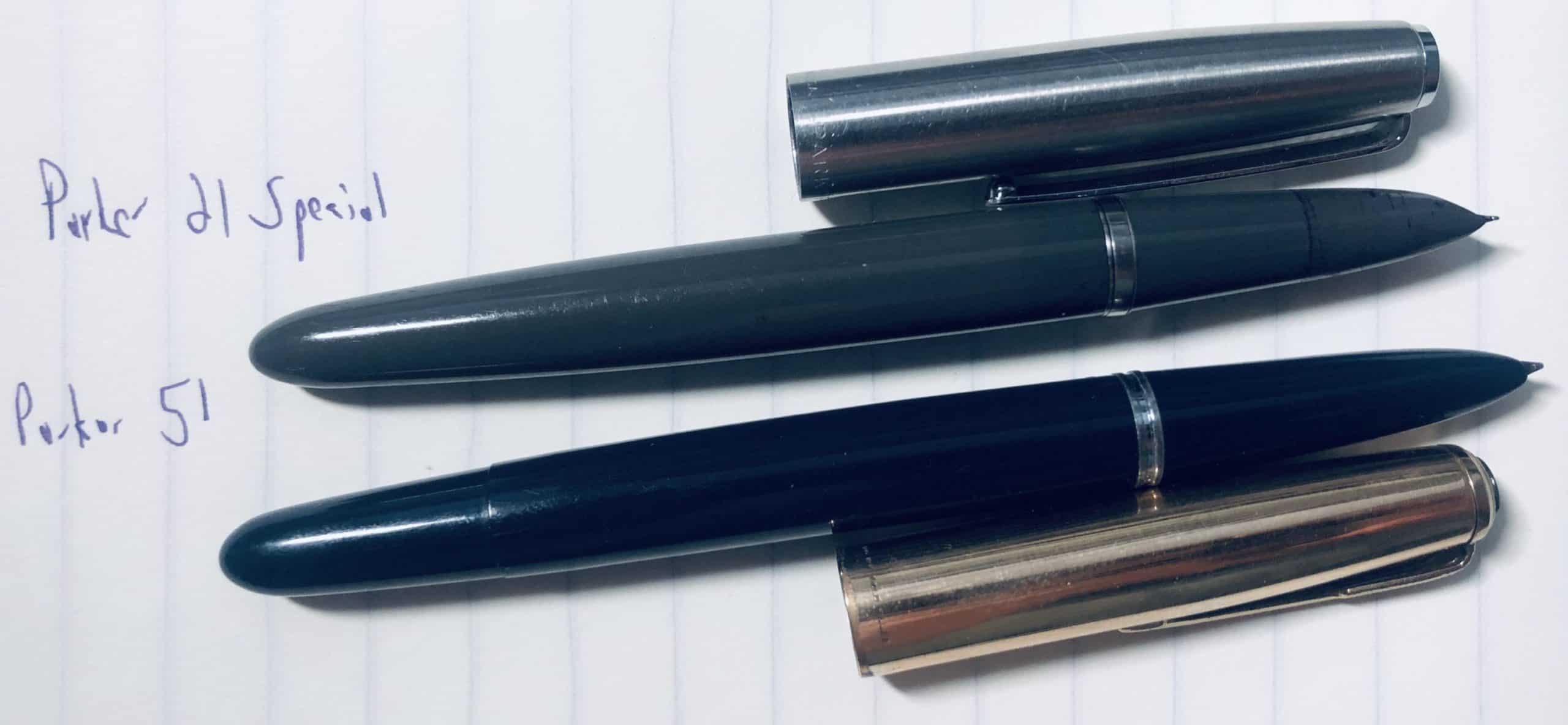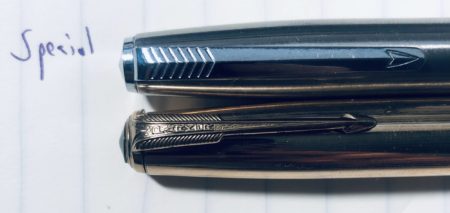The Parker 51 is one of the most famous pens of all time. Even today, over 50 years after this fountain pen first went on sale, the pen is sought after by collectors and mint models can go for hundreds of dollars. The Parker 21 looks almost exactly like the Parker 51, but sells for a fraction of the amount.
What’s the difference between these two vintage fountain pens?
Please note: This guide will speak in relative broad strokes about telling these two pens apart. We are aware that each of the pens were sold in multiple generations (Mark I, Mark II, and so on) as well any number of different models that adds complexity to describing them. That noted, the guide will focus on the major and expect-able differences between a typical 51 and 21 that someone might buy today.
Background
The Parker 21 was Parker’s own response to the success of the 51. In the last 1940s Parker has a definitive hit on its hands with the 51, but it was a high-end, expensive pen with a gold nib. The Parker 51 wasn’t the pen for everyone, thanks to its price, but the Parker 21 — as a cheaper alternative — could be.
In 1948 when the 21 was first sold it retailed for $5 where the 51 sold over $12 and over.
In summary, the Parker 51 was a high-end fountain pen, the the Parker 51 Special was a downgraded Parker 51, and the 21 Super was a high-end student fountain pen.
Parker 21 vs. Super 21
Keep in mind that the Parker 21 was also released as the “Super 21” in 1953. Super 21 fountain pens are much more commonly available from secondhand sellers today, so if you are looking at a 21 there is a good chance it’s a Super 21.
The easiest way to identify the Super 21 is by the clip. The standard 21 (both the original Mark I and the updated Mark II) have plain clips (convex on the Mark I and concave on the Mark II) while the Super 21 has a quite modern-looking Parker arrow on it. This is an imperfect method as caps can be swapped or replaced over the years.
The Super 21 also has a small intake (the black piece at the underside of the nib) that follows the contours of the pen’s body. The Parker 21 has a large intake area that is concave and bulbous.
If you remove the barrel you can see that sometimes the pen will say “Parker 21” or “Parker Super 21” on the aerometric filler. Not all pens will have this, but some do.
Nib
This is one of the most surprisingly things about the Parker 21 and Parker 51 comparison: both of the pens use the hooded (mostly hidden) nib that is so closely associated with the Parker 51. Both nibs have zero flex to them and basically no line variation.
The 51 uses a 14K gold nib and the 21 uses a stainless steel nib. Parker called the steel “Octanium” because eight elements were used when producing the steel, but this was simply clever marketing.
Body
Costs were also cut on the body of the 21 relative to the 51. The 51’s barrel and grip section are made of a high-end plastic material known as lucite. The 21 uses a cheaper plastic (polystyrene) that hasn’t aged as well as the 51’s and is more prone to cracking.
Cap
Like the other features of the two pens, the caps are quite similar. Both use slip-on caps that have no screwing or snap actions. But there are notable differences as well.
The Parker 51 cap sometimes has a plastic “jewel” piece at the end. This was only found on the vacumatic models. The 21 simple ends in a conical piece of metal.
The Parker 51’s cap has a nicer fit to the body thanks to the internal “clutch” system. (US Patent US2278907A). The was designed to give the cap a better fit to the pen body and make taking it on and putting it back easier. The Parker 21 lacks this feature and simply has a friction bit.
Clip
The Parker 21 and Super 21 had a convex clip with a ridge running down it, than a “trough” clip with a concave downward angle, and then, finally, a Parker arrow stamped into the convex clip. The final design, found on the Super 21, is not an arrow-shaped clip, but rather an arrow’s outline on a clip.
The Parker 51 always had arrow-shaped clips, with a distinctive arrow-head and fletchings. The clips are much more ornate than any found on the 21. Some Parker 51 fountain pens also had a jewel on the clip.
Filling Mechanism
The Parker 51 was sold with a squeeze-style “aerometric” filler and, before that, a push-button “vacumatic” one.
The Parker 21 was only sold with the aerometric style.
On some of the pens it said “Parker 21,” “Parker 21 Super,” or “Parker 51” on the aerometric filler’s side, but this wasn’t always the case.
Anything we missed? Please contact us and we’ll update!

